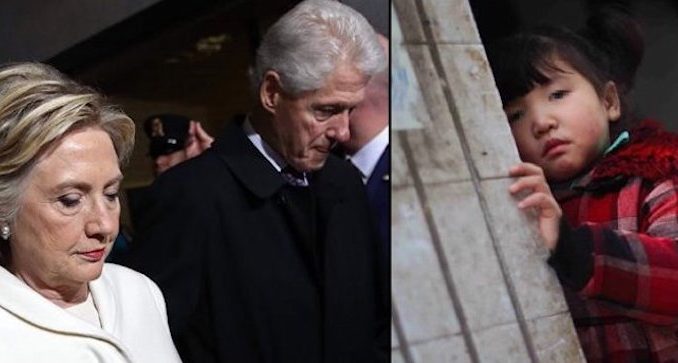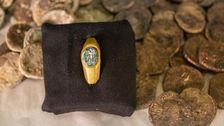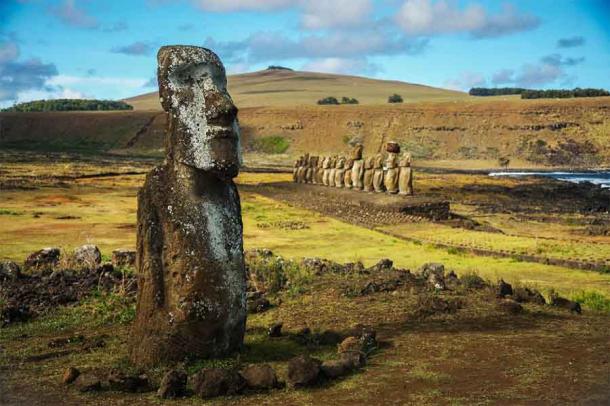Painted on a pillar within a ceremonial hall, archaeologists have found a 1,400-year-old “two faced man”, with cosmic associations.
The Moche culture was a pre-Columbian civilization that thrived between 100 BC and 700 AD, farming and fishing, in the northern coastal region of Peru. Known for their exquisite pottery featuring animals, people, and scenes from everyday life, they were also skilled metalworkers and produced fine gold and silver jewelry.
Now, a team of archaeologists have discovered two 1,400-year-old murals depicting two-faced men within a ceremonial hall. According to a report in Live Science , the two-faced men might refer to sacrifice, and “cosmic realms”.

Upper and lower men are visible here on the pillar. Archaeologist Gabriela Cervantes Quequezana examines the imagery of the painted pillar. (Lisa Trever/ Panamarca)
Rediscovering Ancient Artisans
Two murals of two-faced men holding unusual treasures were unearthed by archaeologists in August 2022 at the 1,400-year-old archaeological site of Pañamarca. Located in Peru’s lower Nepeña Valley province of Huari, in the Ancash region of coastal Peru, the site features a large complex of stone structures including a central plaza, several temples, and residential areas. The murals were drawn between 550 AD and 800 AD, at the height of the Moche people’s rule of northern coastal Peru.
The archaeological work was conducted by the Archaeological Research Project (PIA) “ Paisajes Arqueológicos de Pañamarca ” which is collaboratively led by the international team of Jessica Ortiz Zevallos, Lisa Trever of Columbia University and Michele Koons of the Denver Museum of Nature & Science (DMNS).
Interpreting The Painted Pillar
The two murals both adorn the same pillar within a large ceremonial hall. One of the murals, located at the top of the pillar, features a man with two faces holding a feather fan in one hand, and in the other hand he holds a goblet with four hummingbirds drinking from it. The second two-faced man is painted on the lower aspect of the pillar and has a moving feather fan in one hand and a stick-like object in the other.

Two images of two-faced men have been discovered at the Moche site of Pañamarca, Peru. Left; The upper figure painted on the pillar holding a goblet feeding hummingbirds, and a feather fan. Right; the lower figure holding a fan and an unidentified stick-like object. (Lisa Trever/ Panamarca)
Both of the two-faced men are depicted with headdresses or crowns and wearing colorful clothing held tight with sizable belts. Lisa Trever is an associate professor of pre-Columbian art history and archaeology at Columbia University , who led the discovery team, and she told Live Science that the reason the Moche artists depicted these two men “is a mystery.”
Probing the Two-faced Men Mystery
Dr. Trever suspects that the ancient artists may have been “experimenting with how to show movement, and two narrative moments at once.” Furthermore, the archaeologist suspects the two men “may be deities,” but she added that this is uncertain because most depictions of deities in Moche art have non-human aspects “like fangs, or the faces or tails or wings of various creatures.” But these two murals, even though they have two faces, “seem entirely human,” Trever noted.
Since uncovering the first mural in 1958, archaeologists have been studying the ceremonial hall at Pañamarca, now for over 60 years. Putting the depictions of two headed men in context, other murals within the ceremonial hall depict a priestess, a serpent and a bat. And according to a statement by the team, despite six decades of study, much of the hall is still unexcavated and it is thought that many more murals are awaiting discovery.

Panoramas of the Moche complex under excavation at Pañamarca. (Aerial drone photography by J. Antonio Ochatoma Cabrera/ Panamarca)
Exploring Cosmic Connections
Trever said one of the interesting things about the hall is the unusual density of paintings within it. This means the team can only excavate selected aspects of the building each archaeological field season. Trever said the team still has a lot of questions about the architecture and its functions and that it’s still unknown how the Moche used this ritual space.
What is known about the ceremonial hall, however, is that it was reserved for use only by priests. The narrow passages and interior spaces suggest ritual use, and that “it was not a public space.” Trever added it was probably open to “the leaders or elders of the community at Pañamarca.” Edward Swenson , director of the Archaeology Centre at the University of Toronto, told Live Science that the two-faced men might have represented “a mortal wearing a mask and thus impersonating or becoming one with [the] supernatural.” Furthermore, a connection with the gods might also be indicated in the detail of the hummingbirds drinking from the goblet.
Picking From the Peruvian Pantheon
Swenson said he interprets the hummingbirds drinking from the cup as “a powerful invocation of the centrality of sacrifice in Moche worldview.” He added that sacrifice served as “a critical mechanism to ensure the circulation of life-giving fluids between beings and cosmic realms.”
Like the Inca of Peru, the Moche people worshipped a wide variety of gods and deities associated with nature, agriculture, and fertility. Their primary gods included “Ai-Apaec,” a god of sacrifice and warfare; the “Decapitator,” who was a god of death and the underworld; and the Moon Goddess, who was associated with fertility, childbirth, and the menstrual cycle. It might be the case that the hummingbird was regarded as a messenger of the gods, transferring sacrificed human souls to the other world/s.
Top image: The two-faced Moche man figure painted on the lower part of the pillar. Two images of two-faced men have been discovered at the Moche site of Pañamarca, Peru. Source: Lisa Trever/ Panamarca
By Ashley Cowie
Related posts:
Views: 0
 RSS Feed
RSS Feed

















 March 17th, 2023
March 17th, 2023  Awake Goy
Awake Goy 




 Posted in
Posted in  Tags:
Tags: 
















